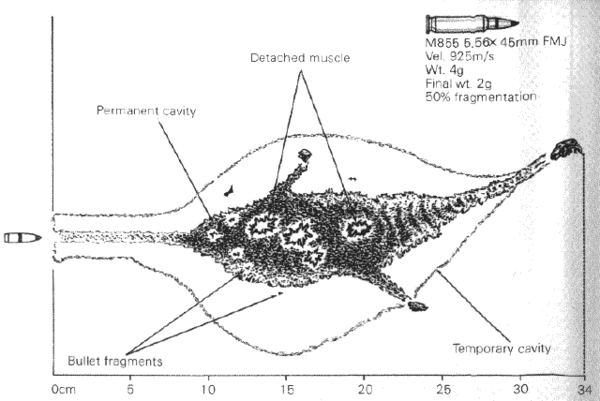For rifles true lethality is a function of marksmanship more than it is calibre. Targeting from the head down the centre-mass to the groin will kill every time. Hit to the central nervous system causes immediate incapacitation regardless of calibre or type of projectile!
The factors that are considered by experts are
"¢Inadequate suppressive effect (fire ignored)
"¢Unreliable terminal effectiveness (erratic yaw)
"¢Lack of barrier penetration (easily stopped or deflected)
While the 7.62 has its shortcomings (weight, recoil, suppression problems) the range and lethality of the 7.62 round is a plus point over 5.56mm.
It is claimed that the 5.56 is better than 7.62 because it has comparable lethality, less recoil and hence, better for the firer to keep the weapon steady and so more accurate., This was more so, because 5.56 has a flatter trajectory and shorter time of flight out to 700 meters. It is said that weapons chambered for 5.56 are lighter, and have better hit probability.
The tactical reason that was said when the 5.56 concept was introduced was that it was felt that it was a better combat spinoff if the enemy soldier was maimed and not killed.
By killing the enemy soldier, be it in attack or defence, it would be the end of story.
On the other hand, if the enemy soldier was maimed, be it in defence or attack, his flailing in agonising pain and howling would be demoralising to the other enemy soldiers and would reduce their resolve and thus would be a psychological force multiplier for those who fired the weapons to maim.
Then after the attack, it would require soldiers, to pick up the wounded, if they are not dead already, in the same pitiable condition, which would demoralise further, apart from reducing the bayonet strength for the counter attack; for the attacker to ward off with reduced bayonet strength the inevitable counter attack that comes after a successful capture of the objective; and for the defender, to muster up the adequate bayonet strength to counter attack the objective lost and regain it again.
Then, though the wounded are taken out of the battlefield to military hospitals by a different route than the route that is used to bring in fresh troops from the rear, yet in mountains and in some other places, this may not be feasible. Therefore, when the convoys taking out the wounded and those which are bringing in fresh reinforcements cross, the horror seeing gruesome injuries demoralises the fresh troops coming in, which reduces their fervour to fight.
That said, there is no doubt that the 'stopping power' of the 7.62 is more than that of 5.56 and that is why sniper rifles are still of the former calibre.
I fully agree with your points but I have only one doubt - don't you think that during any confrontations,the heavier M80 bullets will give the Pakistanis advantage in the maximum range compared to their Indian Army counterparts??



